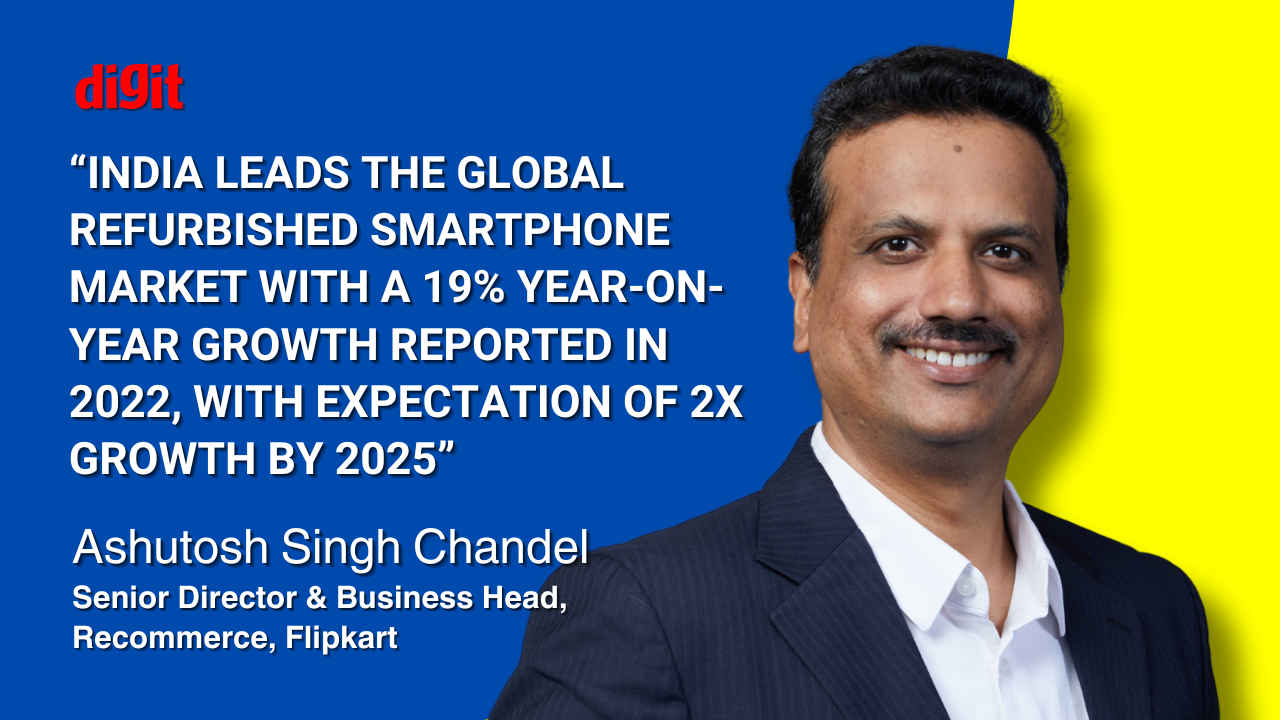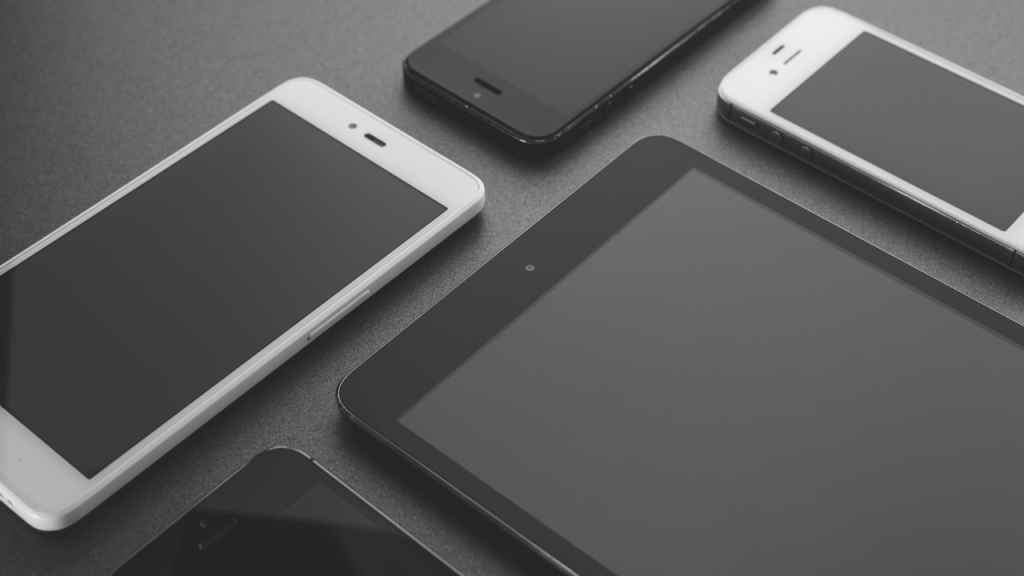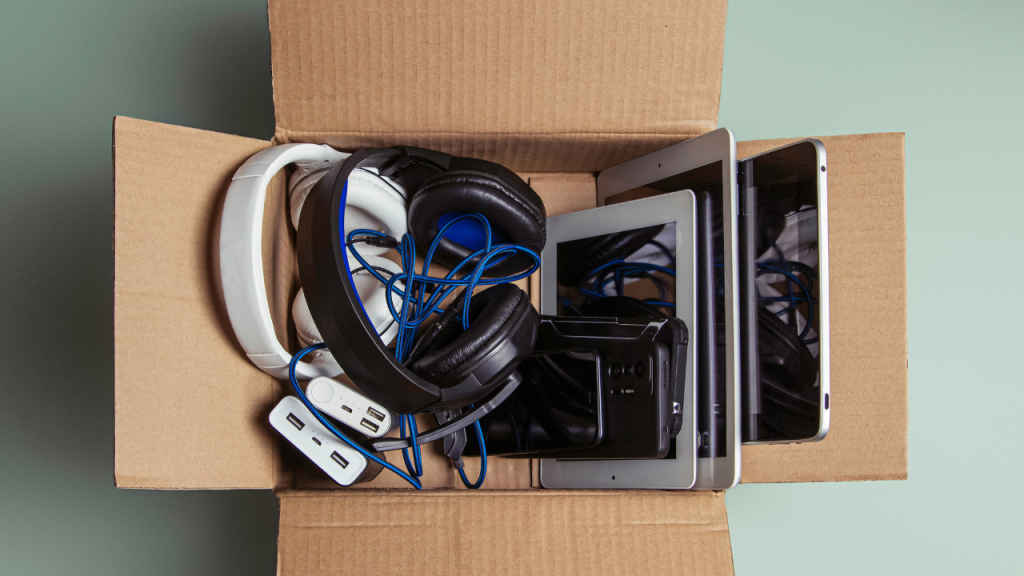India’s refurbished smartphone market booming: Flipkart’s Recommerce Business Head

As India’s refurbished gadget market booms, Flipkart unpacks the refurbished tech mantra into the evolving consumer perceptions, driving forces, and the future of re-commerce in a tech-savvy nation like ours. “India leads the global refurbished smartphone market with a 19% year-on-year growth reported in 2022,” according to Ashutosh Singh Chandel, Senior Director & Business Head, Recommerce at Flipkart.
 Survey
SurveyAlso read: Inside Flipkart’s Big Billion Days: Automation, new features, and tackling customer trust challenges
He also points to the growing trend towards sustainability and circular economy among consumers, which is driving the demand for refurbished products globally. In India, this trend is picking up momentum, with expectations of 2x growth by 2025.
How has the perception of refurbished gadgets evolved in India over the past few years?
The perception of refurbished gadgets in India has undergone a significant transformation in recent years, evolving from scepticism to acceptance and preference. This shift is primarily driven by a confluence of factors. Increasing disposable incomes coupled with the desire for premium technology has led to a surge in demand for smartphones, gadgets and appliances. However, the high costs of these devices often pose a barrier to entry for a large segment of the population. Especially in the smartphone segment, frequent phone upgrades by consumers, driven by OEMs’ rapid release cycles, are fuelling India’s booming second hand smartphone market (or refurbished smartphone market). This trend is particularly evident following festive sales periods when new phone purchases surge, leading to increased supply of used devices.
Manufacturing and mining account for 85-95% of a phone’s annual carbon footprint. According to the International Journal of Life Cycle Assessment (2021), this footprint can be brought down to 55% by refurbishing, as compared to buying and using a smartphone for 2.5 years. Refurbished gadgets offer an alternative by providing high-quality devices at significantly affordable price points.
Furthermore, the growing environmental consciousness among Indian consumers has played a pivotal role in driving the demand for refurbished products.
What are the key consumer segments responsible for the growth of the refurbished gadgets market?
The refurbished gadgets market in India is propelled by two primary consumer segments, budget-conscious consumers that aspire for premium devices and environmentally conscious individuals. The former segment seeks affordable yet quality devices, primarily in Tier II and Tier III cities. In contrast, environmentally conscious consumers, predominantly in urban areas, are driven by sustainability concerns. While both segments contribute to market growth, their motivations and purchasing behaviours differ significantly. As the market matures, we are also witnessing a convergence of these segments. Increasing environmental awareness and growing disposable incomes is leading to a larger consumer base that values both affordability and sustainability.

How does the refurbished gadgets market in India compare to other global markets?
India’s refurbished gadgets market is experiencing exponential growth compared to global markets, primarily driven by a burgeoning young and environmentally conscious population, increasing disposable incomes, and a rising preference for affordable yet quality products. For instance, in 2021, Latin America and India registered the highest growth rates of 29% and 28%, respectively, in refurbished smartphones. Moreover, India leads the global refurbished smartphone market with a 19% year-on-year growth reported in 2022. The trend towards sustainability and circular economy is driving the demand for refurbished products globally. In India, this trend is picking up momentum, with expectations of 2X growth by 2025. Overall, India’s refurbished gadgets market is not only growing rapidly but also leading in terms of volume growth compared to other markets. A report by ICEA and IDC predicts the second-hand smartphone market to reach 51 million units by 2025, valued at $4.6 billion. Flipkart’s strong recognition, extensive logistics network, and customer trust position us uniquely to capitalise on this growth.
What is Flipkart’s vision for the refurbished gadgets market in India?
At Flipkart, our vision for the refurbished gadgets market in India is to create a sustainable and organised ecosystem where customers can access high-quality, pre-owned electronics at affordable prices. We believe that recommerce is not just a business model but a commitment to the environment and a circular economy. It’s about giving gadgets a second life, reducing e-waste, and making technology accessible to a wider audience. We ensure that every refurbished product meets stringent quality checks, thereby building customer trust and satisfaction. Today in key segments across mobiles and appliances every 1 one in 3 consumers are choosing to give back their old devices to Flipkart which helps us fuel the growth for recommerce business.
How does Flipkart ensure quality in the refurbished tech gadgets it offers?
We have invested significantly in building a robust recommerce ecosystem, including a state-of-the-art refurb factory with a capacity of more than 80k+ phones/month and the strategic acquisition of Yaantra in 2022. Our tech-driven approach ensures every device undergoes stringent quality checks and is evaluated and graded accurately using our proprietary Flipkart Diagnostic app. This transparency in pricing reflects the true condition of the product. Moreover, our technology enabled testing processes for critical functions minimize human error, guaranteeing that customers receive devices in optimal working condition.
Beyond quality, we prioritise authenticity and transparency. All refurbished products undergo rigorous verification to ensure they are genuine. Our platform provides detailed product information, including condition reports, to empower customers to make informed decisions.
What role does technology like AI play in Flipkart’s recommerce business?
AI is a game-changer for the recommerce industry. By automating processes like product valuation, image recognition, and quality assessment, AI significantly enhances operational efficiency and reduces costs. Moreover, it empowers dynamic pricing strategies based on real-time market trends and consumer behaviour. On the customer-facing side, AI-driven personalized recommendations and condition reports build trust and loyalty. As a result, recommerce businesses can scale operations, improve margins, and contribute to a more sustainable future.
Also read: Flipkart’s refurbished phone business: Buying and selling of used phones explained
By continuously investing in technology and AI for better and more objective doorstep assessment at the time of old device pickup, Flipkart aims to build a sustainable recommerce ecosystem that benefits sellers and customers.
AI and machine learning play a pivotal role in enhancing the quality assurance processes. By leveraging advanced algorithms, we can efficiently analyse vast amounts of data to identify potential defects and anomalies in devices. To further optimise our refurbishment process, we are exploring the use of AI in accurate assessment of cosmetic condition of devices.
How is AI being used to personalise the refurbished gadgets buying experience for customers on Flipkart?
Currently we are selling refurbished devices through a network of resellers who buy the devices using Flipkart reset for Business app. Our endeavour is to provide accurate assessment of device condition for the buyers and AI will play a critical role in bringing that transparency by providing an accurate assessment of the physical condition of the device.
What are the key trends shaping the refurbished tech gadgets market in India?
The refurbished tech gadgets market in India is evolving, with a notable shift in consumer preferences towards more sustainable and cost-effective options. The rising cost of new products has prompted consumers to explore refurbished electronics, which offer similar features at an affordable price. The market is experiencing a boom in organised sellers, enhancing the availability and trustworthiness of these products.
Online marketplaces have emerged as key players, providing convenience and a broad range of choices for consumers. The industry is also seeing an uptick in environmentally friendly alternatives and a growing confidence in the quality of refurbished items. With the market for used electronics projected to reach $11 billion (by value) by FY26 and expanding at a 16% compound annual growth rate, it’s clear that tech-savvy buyers are increasingly drawn to refurbished smartphones, laptops, and other electronic devices for their high-end features at competitive prices. Enhanced refurbishment processes and transparent pricing have further solidified consumer trust, making online platforms the go-to shopping destination.

Our recent introduction of the Exchange Program for non-functional smartphones and appliances is a testament to our commitment to a circular economy. This allows customers to exchange their defunct large and electronic appliances for upgraded products ranging from appliances like television, refrigerators, and washing machines to laptops, smartphones, and feature phones. Apart from attractive value for their old devices, customers can also enjoy the convenience of getting devices assessed and picked up at their doorstep.
What are the major challenges faced by the refurbished gadgets industry in India?
One of the primary challenges is the consumer perception of refurbished products, which often associates them with lower quality or reliability. Additionally, the logistics of collecting, refurbishing, and redistributing gadgets at scale is a complex operation that requires significant investment and coordination. To address these challenges, Flipkart is proactively implementing stringent quality checks and offering warranties to boost consumer confidence in refurbished products. On the logistics front, we are leveraging our robust supply chain infrastructure to streamline operations with a vision to organise the largely unorganised sector.
However, unique challenges persist in India’s refurbished market. Consumer trust and perception of refurbished products remain key hurdles. Building a robust trust ecosystem, ensuring product quality, and offering comprehensive warranties are crucial. Additionally, the lack of standardised refurbishment processes and organised supply chains pose operational challenges. To address these, Flipkart is investing in state-of-the-art and tech-driven refurbishment facilities, stringent quality checks, and transparent certification processes. By establishing trust and offering a wide range of certified refurbished products, Flipkart aims to revolutionise the refurbished gadgets market in India.
Jayesh Shinde
Executive Editor at Digit. Technology journalist since Jan 2008, with stints at Indiatimes.com and PCWorld.in. Enthusiastic dad, reluctant traveler, weekend gamer, LOTR nerd, pseudo bon vivant. View Full Profile